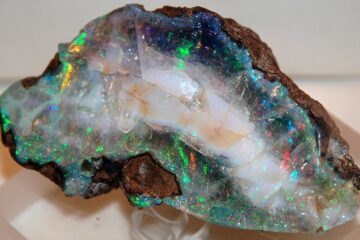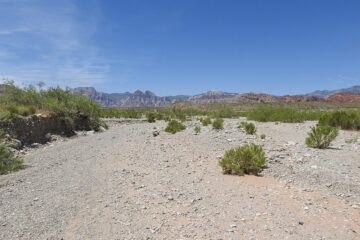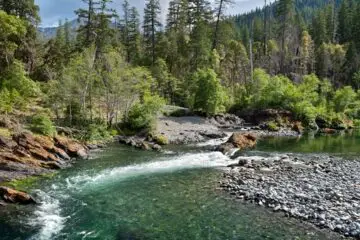Where to find gold at Rich Hill, Arizona
Rich Hill in west-central Arizona has dealt fortune to scores of men. This massive mountain of Precambrian granite, cracked and pitted by titanic forces, still gives up its hidden treasures. Small patches of virgin ground can still be found by the careful prospector armed with a good gold detector.
Rich Hill lies between the deeply eroded canyons at Antelope Creek on the west and Weaver Creek on the east. It is known as the richest placer deposit ever discovered in Arizona.
Angular gold specimens can be found on the flats ranging for many miles in distance. Most of the large rounded gold nuggets are found along the top and sides of Rich Hill itself, also in some areas of the hill, you can find gold in quartz, crystalline gold, gold in hematite, and gold pockets in schist and caliche.
Rich Hill also has more than gold. Very fine gem garnet can be found here. Also, there is scheelite in commercial quantities, and a highly mineralized vein of pegmatite runs into the hill on the Weaver side.
Last I checked, the road into the Potato Patch is behind a locked gate, and under active claim. There are many other areas in the vicinity where large nuggets are still found though. Check land status in the area. Here is a post that will help with that. Also here is a link to mindat, which shows past gold-producing areas all around Rich Hill.
History of Rich Hill, Arizona
Stories of the geological paradox of Rich Hill have circled the globe ever since the placers were discovered in 1863 by a group of California prospectors known as the Peeples’ Party. Mountain man and guide Pauline Weaver joined them at Yuma and led the party into the Rich Hill area in what later became known as the Weaver Mountains.
It has been said that Weaver had previously been through the area and observed formations indicating the presence of gold.
Three prospectors of the original Peeples’ Party discovered the placers atop what became known as Rich Hill while looking for a runaway horse.
Not expecting to find gold so high on the mountain, they had left their pans behind. As they probed the gravels with hunting knives, each man was able to gather up about $600 that day before returning to the main party with their news.
Peeples, a knowledgeable prospector knowing where to look for likely concentrations of the free gold, was said to have picked up $7000 in nuggets before breakfast on his first visit to the top.
As the prospectors skimmed off the cream of the nugget crop, the news traveled and a rising tide of gold seekers flooded in. They built up the communities of Stanton, Weaver, and Octave in the foothills of the Weaver Mountains below Rich Hill.
The communities are about seven miles east of Congress. There was much violence in these towns and gunfights were frequent. Straying into the wrong camp often was tantamount to committing suicide. This state of affairs continued until an Army detachment moved in to quell the disorder.
The potato patch field yielded an estimated million dollars in recorded gold. To this can be added another million stashed away and stealthily removed. Other areas close to Rich Hill, including Antelope and Weaver Creeks, reportedly produced close to another million.
Today only a few shacks stand in the once-flourishing town of Weaver, and virtually nothing remains in Octave. Stanton has had a better fate. Its antique hotel and saloon remain largely intact, and the ghost town is now also home to an RV park.
Untouched Gold Deposit
The following was compiled from an article in the February 1958 issue of Desert Magazine by William Esenwein titled “I found Gold on Rich Hill”
It gives some good clues for prospecting in the area. It starts at the rock house ruins near the Potato Patch.
Instead of returning to Stanton by the long winding summit trail, I decided to save time by short-cutting over the western escarpment of the mountain. By late afternoon of the next day I had completed my first quarter-mile of descent into a deepening gorge piled high with tier upon tier of boulders
A long drop landed me on a shelf of gravel spotted with hematite in greasy-looking irregular chunks and worn cubes, some pieces in settings of quartz. Gold was written all over this ground.
The returns on surface material have averaged $1 ($50 in 2021) a pan in fine gold. They increase at least $1 ($50 in 2021) a pan for every foot of depth. Small nuggets and coarse gold are found at three feet where clay cemented gravel begins to show.
The depth of bedrock is uncertain, but I estimate it to be about 10 feet. The nuggets on bedrock will decisively influence the total value of the discovery. I expect them to be very large and plan to get them the hard way, inch by inch and trip by trip.
Most untouched deposits, such as the claim I staked in the gorge and named The Aurora, require the sure-footedness of a mountain goat to reach.
Six years of placer mining on this mountain have convinced me that this legend is no myth, and that much wealth remains undiscovered.
In times long past, the irregularities in the basin bedrock trapped the heavy nuggets which somehow had found their way to the summit, just as today the same irregularities catch and hold the finer gold.
After hard rains, a teaspoonful of black sand concentrate from certain V-shaped traps may contain $1 ($50 in 2021) worth of yellow metal. This content was once so high that the gold of the basin literally overflowed into surrounding canyons.


